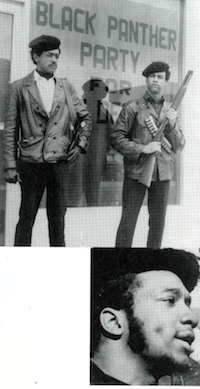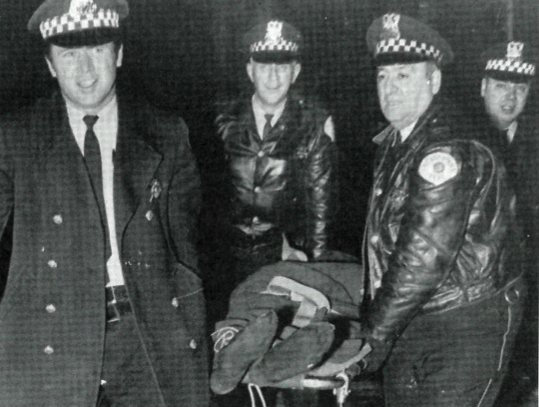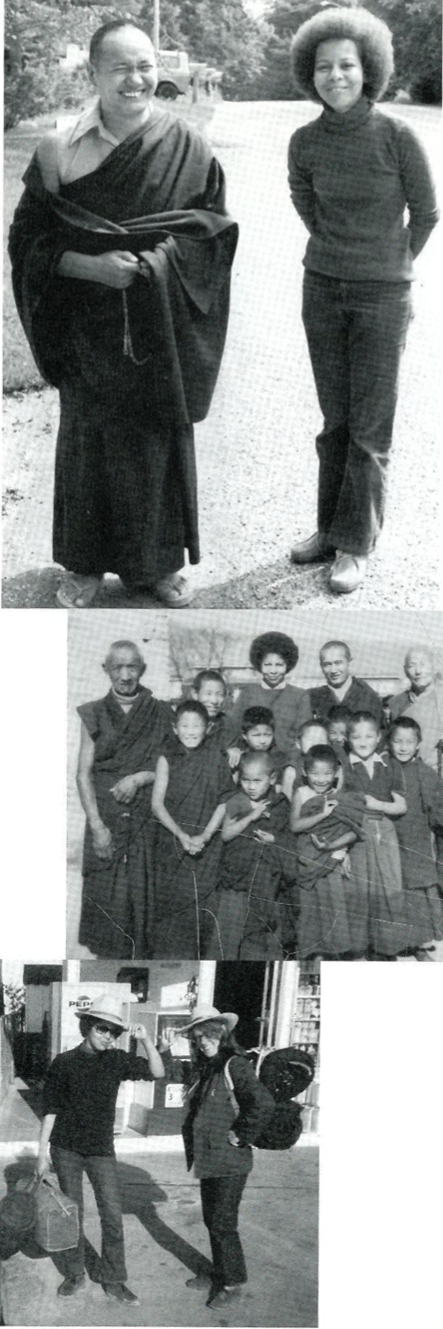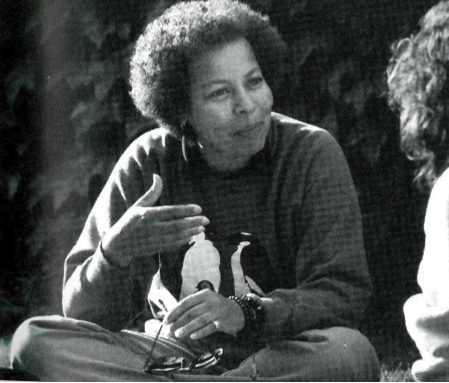Jan Willis’s critical choice: join with the Black Panthers in an armed fight for freedom, or return to Nepal to study the dharma. This was the decision she faced upon graduating from Cornell University in 1969.

I had already made up my mind to return to Nepal after leaving Cornell when I picked up a copy of Time magazine and read the story about Fred Hampton’s tragic death. As they slept in an apartment at 2337 W. Monroe Street in Chicago he and one of his comrades had been shot to death. The pictures of the room showed blood-splattered walls and bodies lying in disarray. I had personally met Fred Hampton earlier that same year when he had given a talk at the University of Wisconsin. Now, that young warrior was dead. The photos churned my stomach. Against guns, we had no chance.
During the summer and early fall of 1969, I had to make the most important decision of my life: whether to join the Black Panther Party or return to the Tibetan Buddhist monastery in Nepal. After the experience at Cornell, I was convinced that, as a thinking black person in this country, I was left no choice but to join the party; to lay my life on the line for my beliefs and for my people’s freedom. Making the choice troubled me every waking moment and invaded my nights.

After graduation I had agreed to a job as a teaching assistant for a philosophy course at Cornell. It was a way to earn income and a place to live after school. I took an apartment just at the edge of Cornell’s Collegetown. As summer’s end approached, I met one of my former college professors to say goodbye. He asked about my future plans and I told him they weren’t decided but that I was considering the two alternatives of Panther Party or Nepal. In a matter of days, he had arranged a luncheon for me with my thesis advisor, himself, and the dean of the college. At that meeting, the three men made me a unique offer: If I chose to, I would be admitted to graduate studies in philosophy at Cornell and I’d be granted my first year there, in absentia. In short, I could return to the monastery in Nepal at Cornell’s expense, with a University Traveling Fellowship.
Before that, however, when I’d participated in the Straight takeover [During Willis’ senior year, she had participated in the Black Student Alliance’s armed takeover of the Straight, the Cornell Student Union building —Eds.], one of the men brought in from outside had given me the name of a key contact with the Panther Party in Oakland, California. If I was serious about my commitment to revolution, he’d said, I had better have a meeting with this man. I felt that I had to follow through and check out this path, this choice, as well. At summer’s end I hitchhiked across the country with Rand and Rob [The author’s best friends at the time, a young couple —Eds.]. On the way, we stopped off to visit other hippie and politico friends. One of our stops was at the University of Wisconsin at Madison. There we were told to check out the campus lecture one evening that was being given by Fred Hampton, the head of the Chicago Black Panthers. Flanked on either side by my friends, I marched into the lecture hall proudly sporting my tall Afro. The three of us were strangers there and we could tell that, among some of the students, there was speculation going on about our identity. At such moments I felt proud that I might actually be thought already to be a Black Panther. Several students moved over and offered us seats up front.

On the stage, two young Panthers stood at attention, clothed all in black, wearing leather jackets and berets. Fred Hampton was introduced. I was surprised that he was so young, I think only nineteen at the time. He was tall and eloquent, delivering a flawlessly rousing speech. He mentioned that as a child he had stuttered very badly, but watching and listening to Panther Party members had inspired him to work on improving his speech so that, now, he could speak like the best of them. It was a moving revelation. The Chicago chapter of the Black Panther Party provided free school meals and health facilities for inner city blacks and other poor. For me, Hampton represented the promise of a better future—through pride and confident action.
After the speech I was invited to join with Hampton and members of the all-black radical student alliance for a reception. When I was introduced to Hampton as being from Cornell, Fred said to me, “Hello, sister. You guys saw some action at Cornell. Yeah I guess you know how to use your piece. Glad to meet you.” His handshake was warm and firm, his smile infectious. I felt proud that he had recognized me in front of the others. At that moment I felt genuinely close to him. I knew, however, that I had just learned to use a “piece” very recently when Mack had taught me to shoot a rifle just after the Straight stand-off. I also knew that I did not look forward ever to having to demonstrate that particular ability. In fact, I now recognized that I was scared to death of guns, preferring peace much more than a piece.
Shortly after we arrived in California we had another fortunate meeting. While searching for a friend who lived somewhere on Mt. Tamalpais, we were caught in the rain and invited to take shelter by a hospitable stranger, a petite young woman, red-haired and freckle-faced. She met us at the door with a large plate of sliced oranges and several marijuana cigarettes rolled in brown wrappers. We settled in to a pleasant, and, as always, political conversation. Her own story left me spellbound. She’d been offered this house as a refuge and respite before she had to begin serving a three-and-a-half year prison sentence in Washington state for encouraging draft resisters.
It turned out that this diminutive woman also personally knew the Black Panther Party contact person I was supposed to meet in Oakland. She said there had been recent rumblings about his abusive tactics with female Panther Party members. Just as had been the case at Cornell, black women were to keep in the background; they were to be the black man’s natural complement, but they were not to take any leadership positions. Yet, at Cornell, in spite of being a black female, I had tasted power. The leadership had consisted of eight seniors, seven men and myself. There I had been in charge of women’s safety. Though I admired the Panthers’ cause, I did not want to have to be a doormat in the background. In a certain sense the power dynamics that operated in society separating blacks and whites were being duplicated here all over again between black men and women. All this information added to my confusion about the decision I faced.
Everywhere we went in California we saw newspaper photos of Huey Newton and other Black Panthers brandishing shotguns on the steps of the Sacramento State Capitol. Everywhere I looked, this brazenly militant movement seemed my only alternative. The images and rhetoric of the Black Panthers pervaded all conversations. Many a morning I woke up in a cold sweat.
Unrelenting questions pummeled my mind: Was I ready to be shot and killed by Alameda County police? Was I ready to serve a prison term like the one that freckle-faced girl at Mt.Tamalpais was awaiting? Would any of my activities really help to turn things around in this country? No matter, wasn’t it time to stand up? Wasn’t it time to stop pleading for justice, and to take up a gun and demand it? A piece or peace? The questions literally shook my mind. I walked around with a constant fever and a buzzing in my head. The closer we got to Oakland, the more the questions tormented me.
My choices could not have been farther apart, and no assurances of success were offered by either. I had always been a good girl, eager to please. I had always shunned the limelight, knowing since early childhood that conspicuousness brought with it danger. It was not in my nature to desire to fight back; the day the Klan showed up, I had wanted to talk. I sought the more peaceful path. Though I thought it seemed awfully cowardly on my part, I could not see myself standing defiantly on the statehouse steps brandishing a shotgun. I talked to myself a lot: The real truth was that I was scared, scared down to my bones.
I was, and am, a Pisces, always deliberating between choices. I knew that either of these choices would freak out my family. I did not want to worry them, but I had to do something. Amidst the revolutionary timbre of the times, I was tossed and pushed along, it seemed inevitably, towards guns and violence. But then, just before taking that fateful step, I bolted. My whole being—mind, body, and soul—bolted. And even though doing so made me feel like a coward and chicken-shit deserter, I had to turn away from it.

True, I had learned to shoot a piece. I had even helped deliver guns to the Straight when I had to. But I had also marched, non-violently amidst violence, in Birmingham with King. And I had wanted to talk with those Klan folk who’d burned a cross in front of our house. “To thine own self be true,” the saying goes, and my sister San had always said, “Trust your first mind.” I decided not to meet with the Panthers.
I didn’t know where the path of Buddhism would ultimately take me, but it seemed to offer at least the possibility of peaceful transformation. I told myself that it offered the best opportunity for clarity—about personal as well as political strategies. Now that I had made that westward journey, turning eastward seemed the best and most viable alternative. I took a deep breath. I felt calmer than I had in months. I picked up the phone to call that professor at Cornell. I would go back to Nepal.
Only a few months passed before I saw the article about Hampton’s death. My heart was saddened to think of him, cut down in his prime. But I had made the right decision.
Thank you for subscribing to Tricycle! As a nonprofit, we depend on readers like you to keep Buddhist teachings and practices widely available.